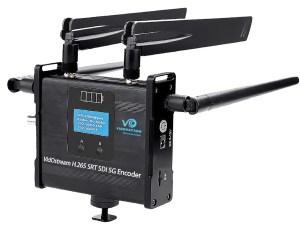
Learn how “5th-gen” wireless tech pairs with broadcasting
By James E. O’Neal, TV TECH
We’ve all heard a lot of hype about 5G, the latest wireless broadband communications technology. 5G is real, is rapidly being deployed, and seems destined to become an increasingly important part of the broadcaster’s toolset.
NAB Show is putting 5G in the spotlight with a number of informative sessions tailored to provide information about the technology and its role in both increasing a broadcaster’s ease and agility in covering live events and helping to trim the costs involved.

This very high-speed wireless connectivity brings with it the potential for replacing conventional wired (and wireless) linkage to cameras at such outside events as sporting matches, music festivals and parades, reducing capital outlay and storage and maintenance expenses. 5G connectivity may even replace the large TV mobile production trucks with permanent centralized facilities linked wirelessly to large numbers of cameras and audio sources located anywhere from a few miles to a continent away.
With such a sea change stirring, it behooves content producers and broadcasters to learn as much as possible about the nature of 5G and how it may be applied to their endeavors.
5G IS WORTH A LOOK
“5G should be looked at from several points of view,” said Stan Moote is chief technology officer at the International Trade Association for Broadcast & Media Technology (IABM). “As the roadmap indicates, COVID-driven adjustments in both working from home and remote production are taking hold, and this means that 5G is becoming a key technology. Remote working means newer methods for collaboration are required and 5G is a clear backhaul contender. With home networks occasionally crashing, 5G also provides a much higher layer of confidence in connection with protected feeds, IFBs and [remote] control functions.”
Video content is being consumed via smart phones, tablets and similar consumer devices at an astonishing rate and shows no sign of leveling off. A recent study forecasts that within five years 5G will be carrying 62 percent of the world’s smart phone traffic and that an astounding 79 percent of that traffic will be video content.

As more and more content producers and distributers tap into 5G for their distribution, the application of open-source tools will be essential in the development and deployment of services. A cross-industry organization, the 5G Media Action Group or “5G-MAG,” has been created to facilitate collaboration of all media distribution stakeholders in the deployment of services via 5G. As a particular effort to respond to the need for software, the 5G-MAG Reference Tools project has recently been established. Since its start in late 2021, a steadily growing developer community is committed to create common open-source reference tools to support implementation and interoperability of 5G Media technologies.
“The Internet is being increasingly used by service providers to expand content reach and by users to consume it at anytime, anywhere and on any device,” commented Thomas Stockhammer, Qualcomm’s director of technical standards. “With mobile technologies driving global video consumption, it is paramount to empower the media industry with the adequate tools to access the 5G media platform. Access to open-source tools to support prototyping, trials and possibly even deployments is of utmost relevance. The 5G-MAG Reference Tools development program is now developing the ecosystem of common open-source reference tools to support the implementation and interoperability of 5G Media technologies. “
WAIT, WE’RE ALREADY TALKING ABOUT 6G? WHAT ABOUT 5G?
6G may already be on the horizon, but there’s still a lot to understand about the benefits — and limitations — of 5G, which is rolling out across the US but has yet to reach peak saturation. Dive into these selections from the NAB Amplify archives to learn what, exactly, 5G is, how it differs from 4G, and — most importantly — how 5G will bolster the Media & Entertainment industry on the road ahead:
- Why 5G is the Cool Thing That Still Hasn’t Happened
- Without a Killer App, We’re Still Waiting on 5G
- Why Is 5G Advanced So Important to 5G Adoption?
- 5G Technology Goes Way Beyond Better Cellphone Service
- 6G Mobile Networks Begin to Take Shape… With 7G Already in the Wings
Mickaël Raulet, chief technology officer at Ateme, discussed the importance of broadcasters learning as much about 5G in connection with TV content delivery.
“Over the last couple of decades, IP technology has transformed our mobile phones into tools to listen to music, store photos, do our banking and much more,” he said. “While the video world is also transforming with IP technology, this transformation is curbed by bandwidth restrictions. 5G promises to change that with higher bandwidth and multi-access edge computing, transforming the way audiences engage with content and creating new business opportunities for broadcasters.”
ROLLING OUT 5G GEAR
Broadcast equipment manufacturers are already rolling out products for tapping 5G networks, and there should be plenty to see on the show floor.
Samuel Fleischhacker, senior product manager at Aviwest, said, “Our new PRO460 5G transmitter is the next evolution of Aviwest’s flagship PRO bonded-cellular transmitter series for remote and at-home video production. It’s a must-have solution for facilitating live remote production over 5G with the potential for greater mobility, productivity, premium quality and massive savings in operational and capital expenses.”

Also, look for Vidovation’s 5G-enabled encoder/transmitter being displayed at the Aviwest booth. And be sure to stop in at the LiveU exhibit to check their LU300 HEVC encoder for connecting to 5G networks.
Additional exhibitors addressing 5G include AVIWEST, Cisco, Dejero, Fraunhofer-Gesellschaft, HISPASAT, NATE: The Communications Infrastructure Contractors Association, NOVELSAT, Rohde & Schwarz, ST Engineering iDirect, Verizon, Viking Satcom and Vislink Technologies.
5G is destined to be a game changer for everyone, and broadcasters need to get in on the ground floor.





